Reality check: B2B social media is here to stay.
In fact, recent statistics note that social advertising is practiced by a staggering 83% of B2B marketers and is second only to search engines in terms of success.
From nurturing customers to flexing your industry influence, the social space has a ton to offer B2B brands.
But there’s no denying that B2B social media is tricky. This is especially true if you’re dealing with what may seem like a “boring” or technical product.
That’s why we put together this step-by-step guide to help B2B brands come up with a social strategy that aligns with their business’ key objectives.
Spell out your business-specific goals
Businesses of all shapes and sizes should focus on setting goals, but doing so is especially important for B2B companies.
After all, competition is fierce and there are so many marketing channels to work with. But you shouldn’t be on social media “just because.”
Also consider that a B2B social media strategy is apples and oranges versus retail or ecommerce. Rather than focus on selling, most B2B companies use social as a top-of-the-funnel marketing channel, specifically for content promotion and awareness.
Based on recent research breaking down the most-cited benefits of B2B content marketing, marketers should prioritize the following:
- Creating brand awareness (86%)
- Educating audiences (79%)
- Building credibility and trust (75%)
Now, let’s look at how B2B social media can be used to address each goal.
Creating brand awareness
First thing’s first: you need to let the world know who you are.
Again, there are plenty of voices in the B2B space. It’s easy to get lost in the shuffle.
Businesses need to spell out exactly who they are, what sets them apart from competitors and what they value as a company. Social media is the perfect place to make it happen, providing a place to promote bite-sized pieces of content that highlight all of the above.
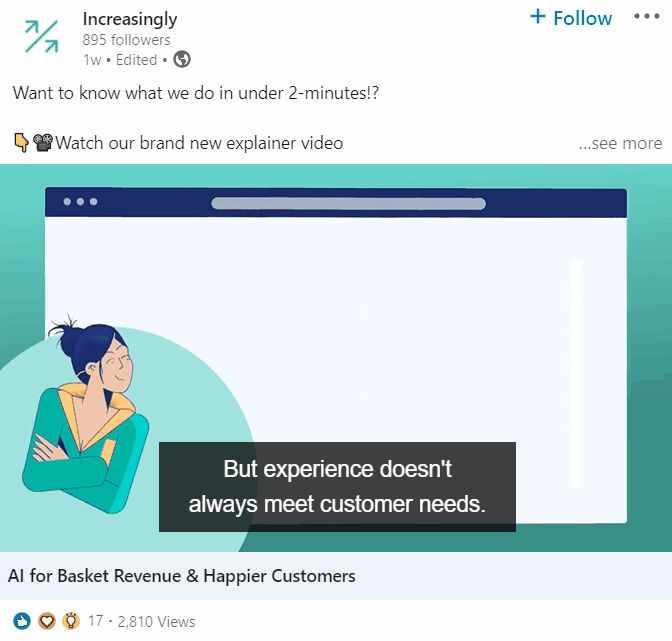
Educating audiences
Fact: the B2B buyer’s journey involves more than just visiting a website or checking out a pricing page. An overwhelming number of B2B buyers do independent research and want to ensure that the companies they support are credible.
Perhaps the best way to cement your credibility is through teaching your audience. From blog posts and e-books to firsthand reports and how-to videos, any B2B social marketing strategy should center around actionable, educational content.
Fun fact: B2B blogs that create education content receive 52% more organic traffic than those that mainly publish content about their company? ? More stats in this B2B Content Marketing Report by @backlinko https://t.co/XwPrIaIvq5 pic.twitter.com/85I97vohxo
— Semrush (@semrush) February 4, 2021
Building trust
With so much competition among B2B brands, anything you can do to build trust and prove your business’s worth is a plus.
Testimonials, positive reviews and accolades (think: awards, customer milestones) are all ideal for sharing and can do exactly that. There’s arguably no better place to both gather and promote social proof than, well, social media.
The G2 Best Software Awards for 2021 were just announced!
We're extremely proud and beyond humbled to be named the #1 Fastest Growing Product AND #2 Remote Work Product of 2021.
Thanks for choosing us as your collaboration partner! Onwards & upwards ? https://t.co/LjfZQN3L7q pic.twitter.com/qjTpbJKwQO
— Miro (@MiroHQ) February 8, 2021
Adopt a customer-centric social strategy
We often hear about the need for brands to be more “human.”
B2B companies are no exception. That’s why you need to put your customers front-and-center throughout your social campaigns.
No matter how technical or niche your product might be, customer engagement can immediately make your brand feel more personable.
For example, consider how Twitter has become a staple of customer service for SaaS marketing. Serving as a timelier alternative to email, social media is a transparent place to go back-and-forth with your customers about questions, compliments and feedback.
Providing positive, proactive customer service not only puts you in your buyers’ good graces but also showcases to prospective customers that you care.
You can drag an empty block to the left or right of the image to control the alignment ? Let us know if you have any questions as you give this a try!
— Notion (@NotionHQ) February 11, 2021
Beyond customer care, consider integrating customer stories as part of your content strategy. Remember what we said earlier about promoting testimonials and positive reviews? Sharing them creates a sense of loyalty among your customer base. Doing so also lets you promote your services without being too in-your-face or salesy about it.
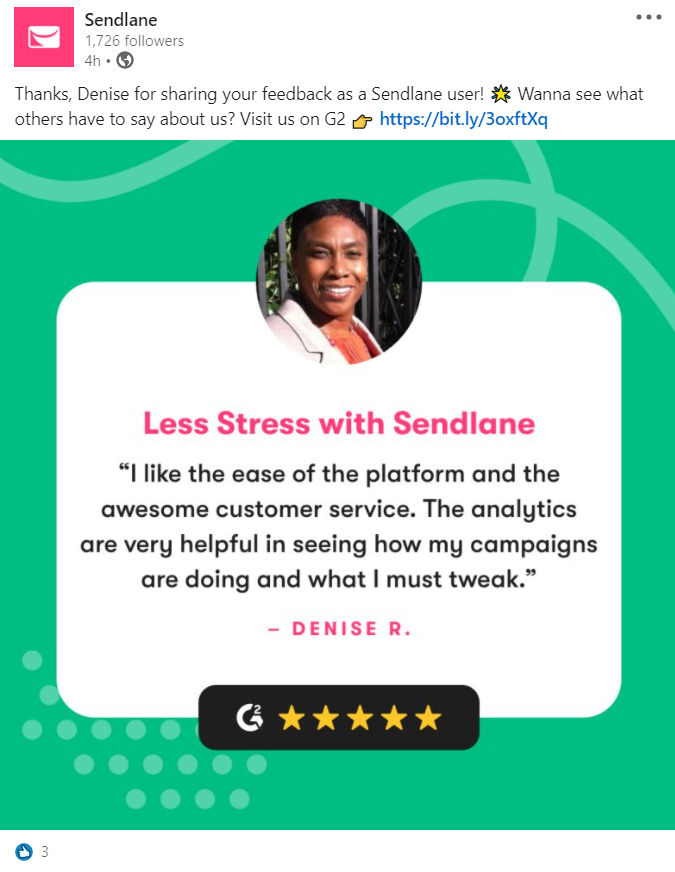
The takeaway here is that customer interactions should be central to your strategy, both in terms of providing service and also producing content. Pay close attention to any and all @mentions and branded keywords to ensure you never miss an opportunity to go engage with a customer.
Align your strategy with your business’ initiatives
This point is worth reiterating.
An oft-cited perception of B2B social media is that there’s little to no ROI.
Why, though? Because many marketers either fail to tie their social media to performance to organization-wide data (think: sales, traffic) or fail to communicate those results across departments.
However, social media is a prime place to support company-wide initiatives. From product launches to PR and beyond, it’s crucial to touch base with folks outside of marketing and provide some much-needed context to your campaigns.
Below is an example of how to use Sprout’s custom reporting to not only measure social media engagement for a product launch but also tell the story behind it to stakeholders.
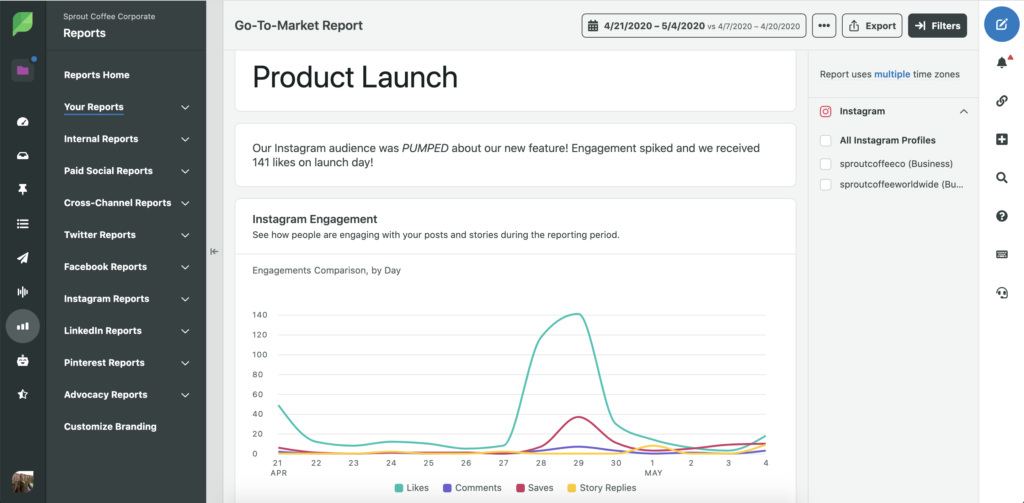
The takeaway here is twofold: measure your social efforts in the context of business outcomes and communicate those findings regularly. Reporting tools like Sprout can make the process so much easier.
Overcome the “boring” business label
Okay, this is the big one.
Sure, terms like “software,” “security” or “finance” might not get people jumping out of their seats.
That said, your prospects will have an inherent interest in your service even if you’re not exactly in a thrilling industry.
Making your social presence less snooze-worthy can be a challenge, but it’s definitely not impossible. Below are some tactics to consider for your B2B social media strategy that can help:
Refine your brand voice
No surprises here: don’t talk like a robot.
A conversational brand voice can highlight the humans behind your social accounts and likewise make you seem more approachable. Despite popular belief, a “professional” voice doesn’t have to be stuffy or rigid.
Email in ClickUp!?? You've got that right! Let us break it down for you: now you can write, send, + receive emails without leaving your Workspace!? Plus create templates, swap signatures, & more. Think that's fire?? Give this bop a listen for full effect.? pic.twitter.com/ZLmzQmzTXX
— ClickUp (@clickup) February 8, 2021
Adapt your content to social-friendly formats
Building more buzz around your content is often as simple as switching up your post captions and formats.
For example, would you be interested in following someone that just drops link after link with no commentary? Below are some ideas to both give your social feed(s) some flavor while also giving your content some entertainment value:
- Convert blog posts or lists into short infographics
- Instead of simply linking a podcast or video presentation, publish a minute-long snippet
- Use Twitter threads and long-form text posts (think: LinkedIn) as an alternative to external links or even blog posts
Remember: the average social user has a microscopic attention span. The formats above are definitely more interesting than links and likewise encourage engagement.
Stay on top of trends
So much of B2B social media centers around trends.
New promotional tactics. Companies rising and falling. Hot takes and industry insights.
It’s important to keep a pulse on what your customers and competitors are talking about on social media. Doing so will make it much easier to both spot trends and chime in on relevant industry conversations.
Oh, and rather than spend all day sifting through Twitter or LinkedIn for news, let social listening do the legwork for you.
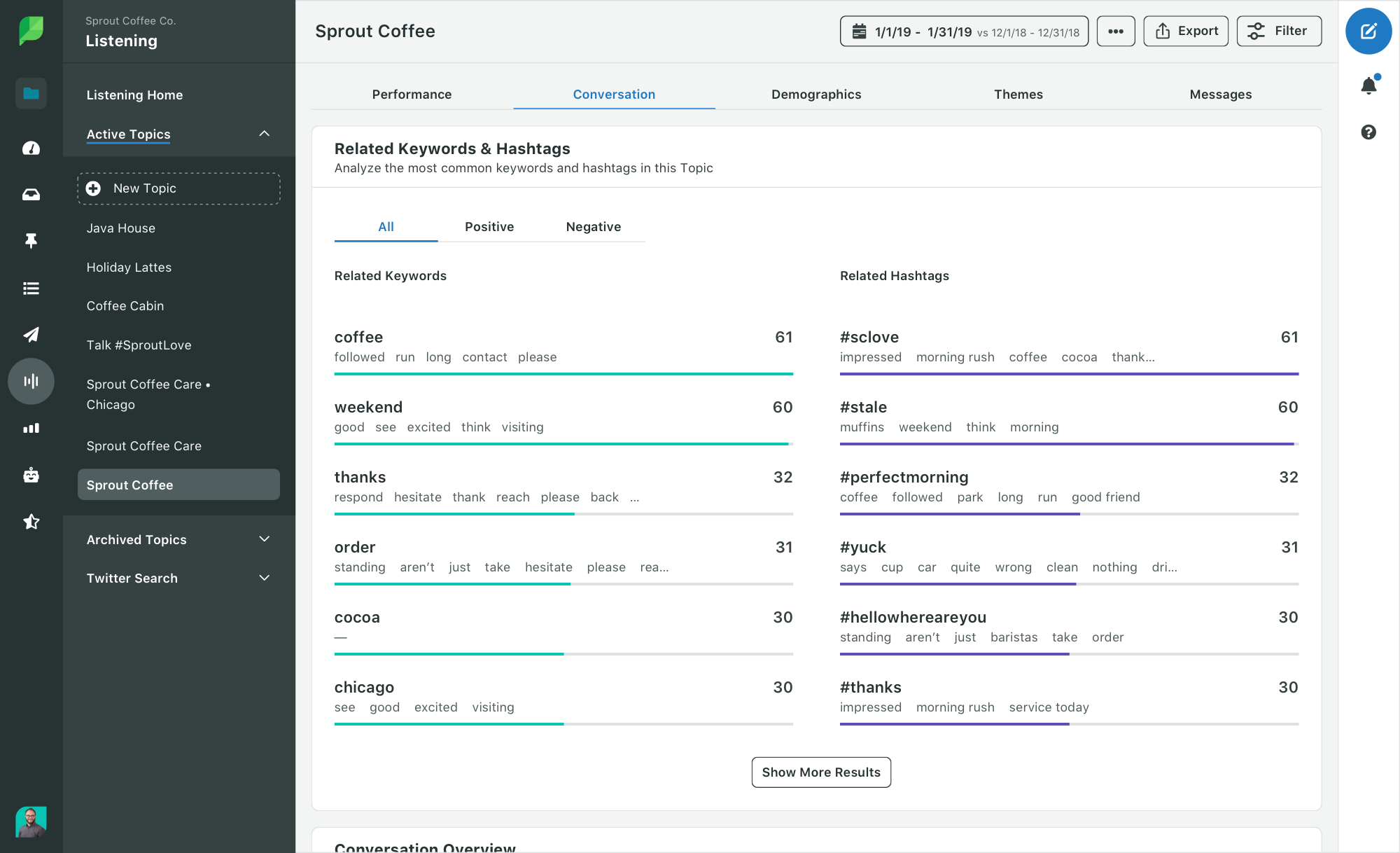
Embrace employee advocacy
Much like you should try to let customers’ do the talking about your brand, the same rings true for your employees.
Who better to highlight your human side than the folks that keep you up and running? Employees can help amplify and compliment your brand voice with a bit of personality, all the while showcasing your company’s culture.
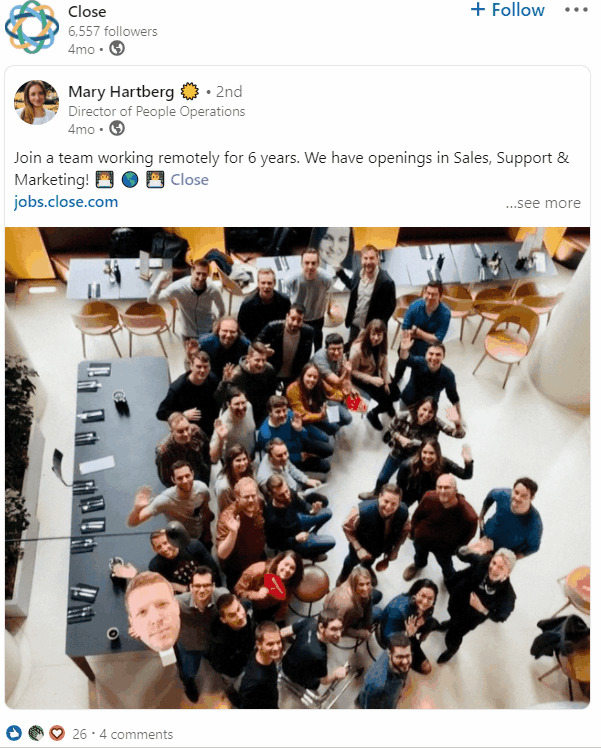
Oh, and it’s well-documented that employee accounts have much greater reach than business accounts alone. Creating a sense of community among your coworkers can really give your social presence a boost.
Focus on the most B2B-friendly platforms
As noted earlier, B2B companies have to use their time wisely when it comes to promotion.
Based on recent research from the Content Marketing Institute, there are a select few channels that are “best” when it comes to B2B social media:
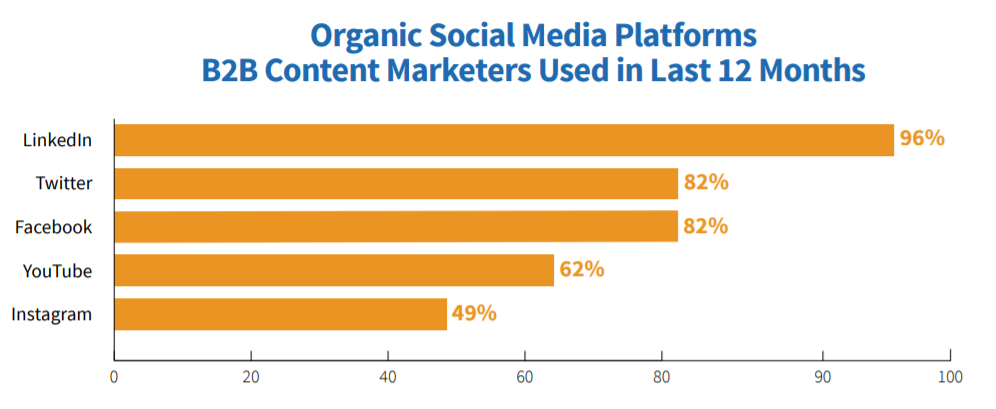
We recommend prioritizing one or two networks so you don’t spread yourself too thin. As both a primer and recap,
- LinkedIn: the ultimate B2B network known for thought leadership content, employee engagement and a robust ad platform.
- Twitter: a prime place to spot trends and interact with customers and business influencers alike.
- Facebook: most Facebook B2B marketing centers around ads, but it’s also a good hub for employee-centric, non-promotional content.
- YouTube: perfect for how-to tutorials, interviews, presentations and commercials.
- Instagram: ideal for visuals (think: infographics, brief how-tos) and culture-centric content
Although there is definitely a growing B2B presence on platforms such as Pinterest, the five networks above are the most important for B2B social media at large.
Use analytics to inform your B2B social media strategy
We said it before and we’ll say it again: reporting and analytics are crucial to B2B social.
Which networks are the most effective? Are your efforts resulting in actual traffic or sales? Is it time to start running ads?
For the sake of proving your ROI and optimizing your performance, analytics can provide the answers.
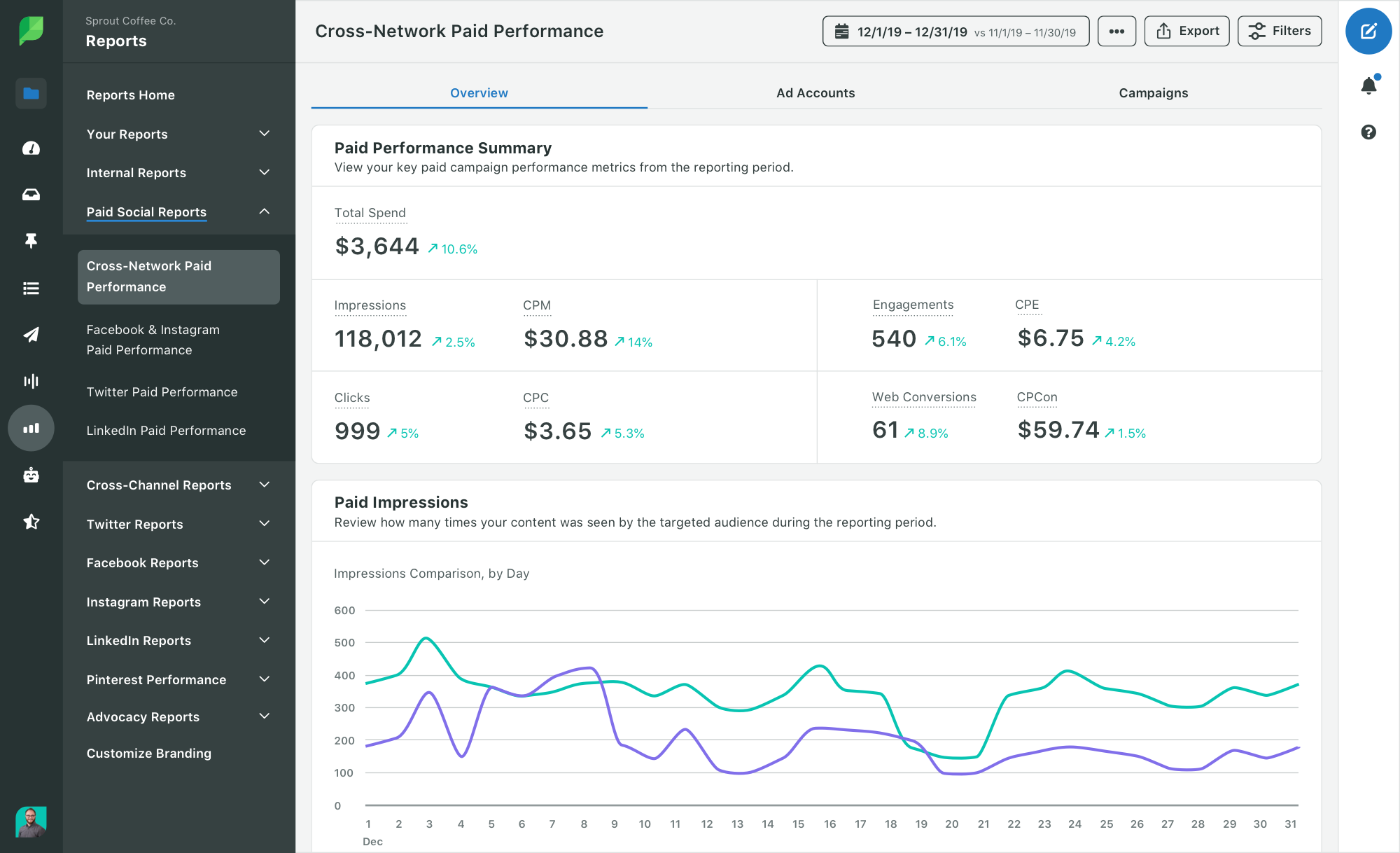
Tools like Sprout social provide a full suite of reporting, listening and analytics tools to support B2B brands regardless of their goals.
Does your B2B social media strategy make sense?
Listen: B2B brands quite literally can’t afford to shy away from social media anymore.
Whether you’re looking to primarily build awareness or promote your content, the best practices above can help guide your strategy in a way that makes sense.
And if you haven’t already, make sure you check out our guide on how to translate your B2B social data into actual revenue.
This post How to build a B2B social strategy (that isn’t boring) originally appeared on Sprout Social.


